On a beautiful spring morning in May of 2011 we found a small group of Sandhill Cranes on a pond as we approached Bear River Migratory Bird Refuge. We were some of the first folks on the access road and our careful approach made two of the birds a little nervous so they decided to vacate the area. I believe they were a mated pair. I got my pickup stopped and my lens aimed just after the first bird began to take off.
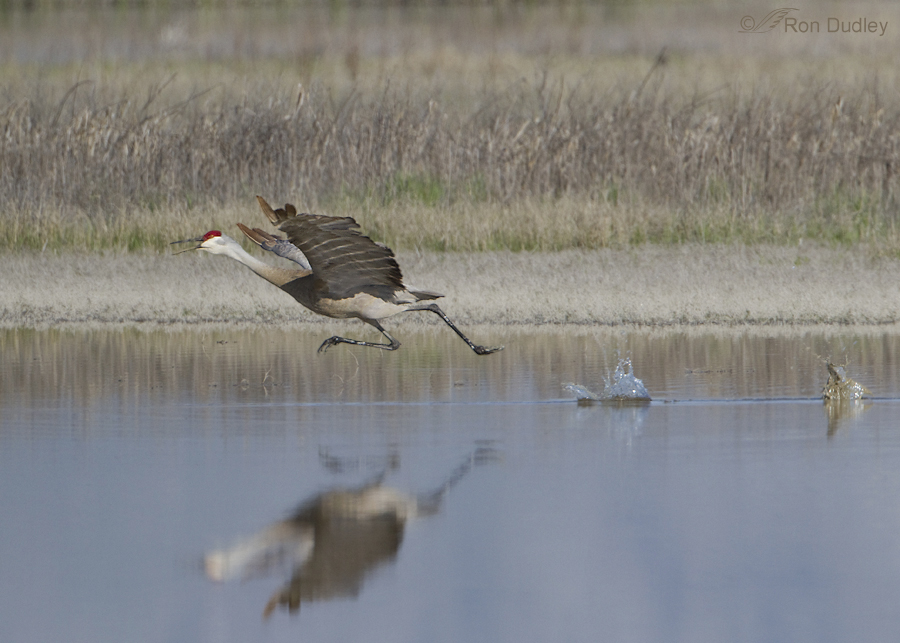
1/2500, f/6.3, ISO 500, 500 f/4, 1.4 tc
I believe this to be the slightly larger male who took off first. The unconventional composition is meant to highlight the water splashes behind the bird.
If you’ve never heard the distinctive, penetrating and very loud bugling calls (also called “trumpeting”) of this species you’re really missing something. As is typical of these cranes, these two were calling during lift off and just looking at these images has that haunting sound bouncing around in my head.
These cranes have an unusual throat anatomy that allows them to make such resonating sounds. The trachea extends and coils down the long neck and well into the sternum. This unique anatomy “expands the amplitude and alters the pitch of the voice by the addition of harmonies”. Until these birds are 9-10 months old they can produce only a series of trilled whistles and peeps but as they mature their tracheas elongate and coil intrasternally which allows them to develop the adult voice.
If you’re curious about their call, check out both the “unison call” and the “contact call” in this link (scroll just over half way down). When you hear it up close in real life the sound goes right through you. It’s haunting – in a good way.
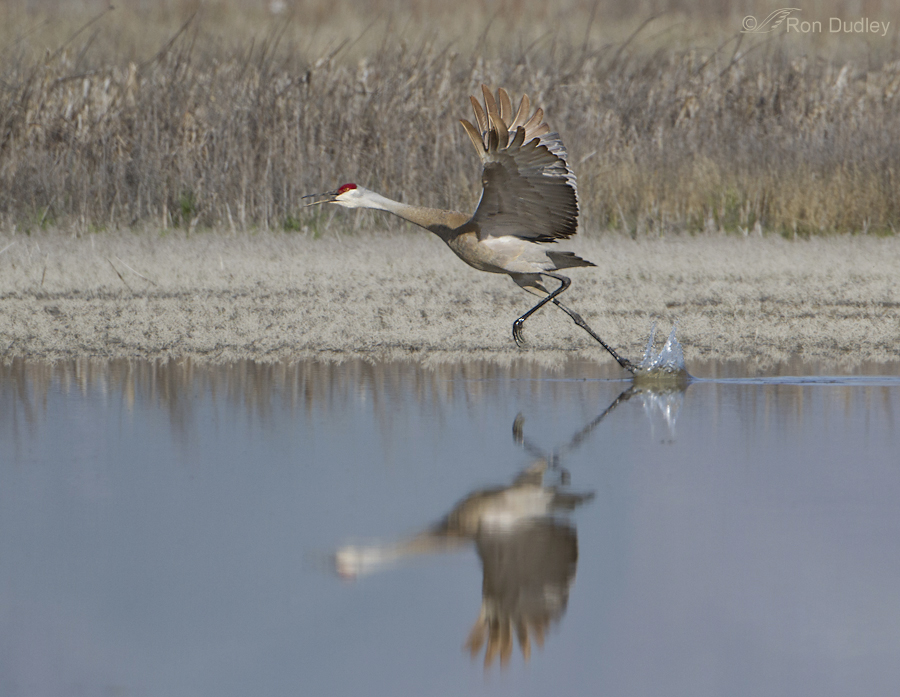
1/2500, f/6.3, ISO 500, 500 f/4, 1.4 tc
When they’re in a hurry to lift off their efforts can produce some athletic poses.
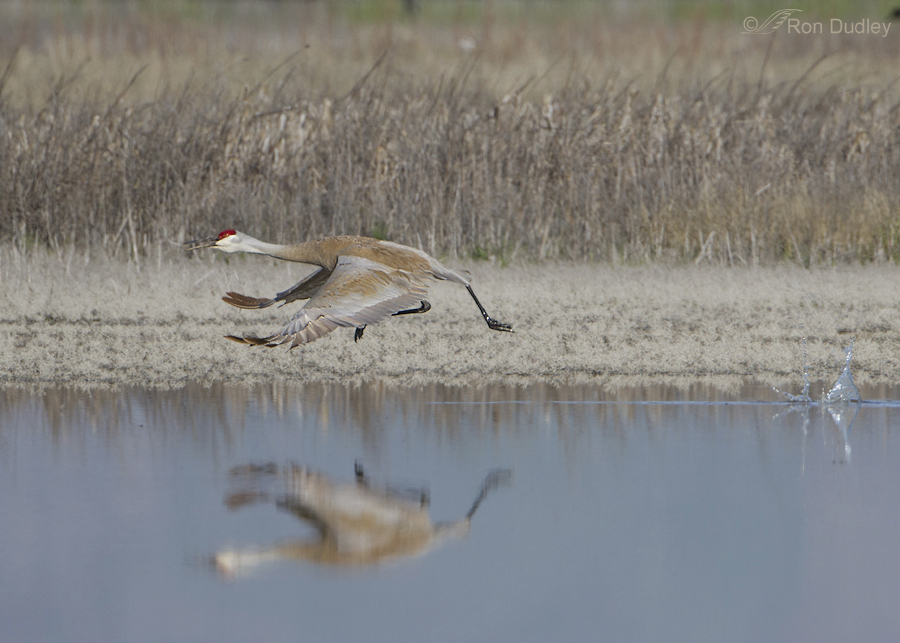
1/2500, f/6.3, ISO 500, 500 f/4, 1.4 tc
Another composition to include the splash behind the crane.

1/2500, f/6.3, ISO 500, 500 f/4, 1.4 tc
The background behind the head is a bit busy here but I like the vertically extended wing position.
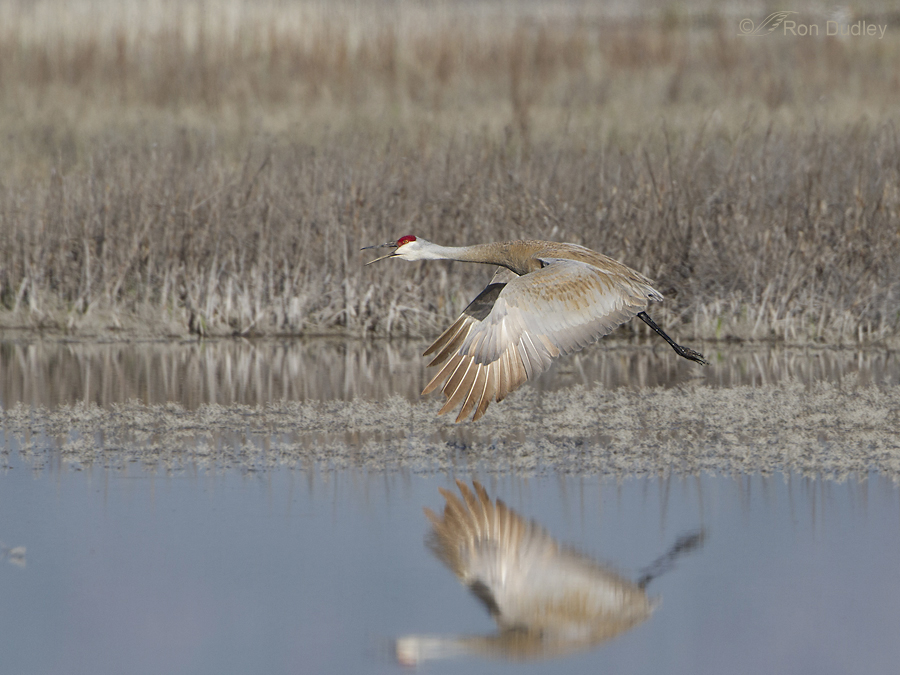
1/2500, f/6.3, ISO 500, 500 f/4, 1.4 tc
By now the male is just about past me so I…
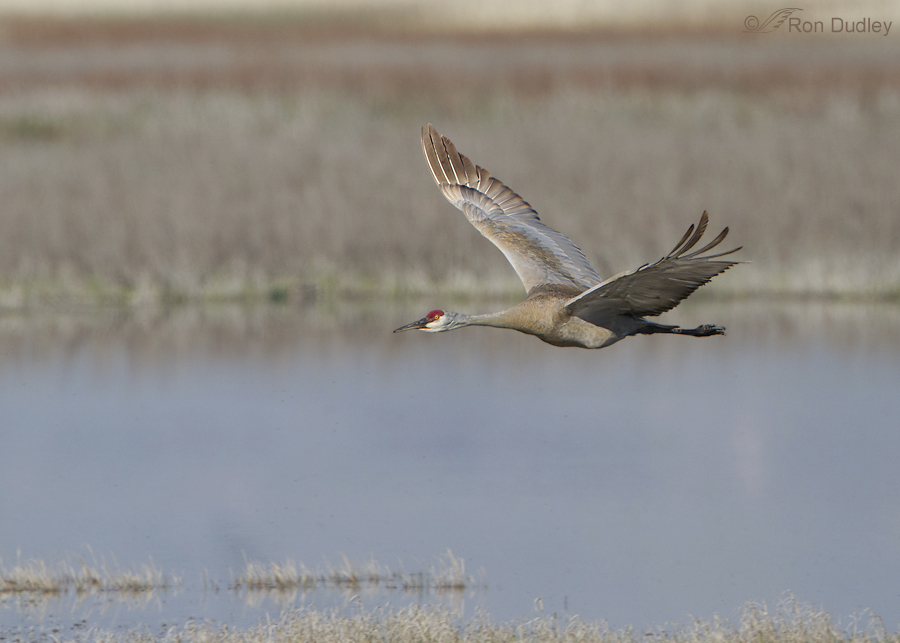
1/2000, f/6.3, ISO 500, 500 f/4, 1.4 tc
turned slightly to my right to concentrate on the approaching female (at least I think this was the female of the mated pair).
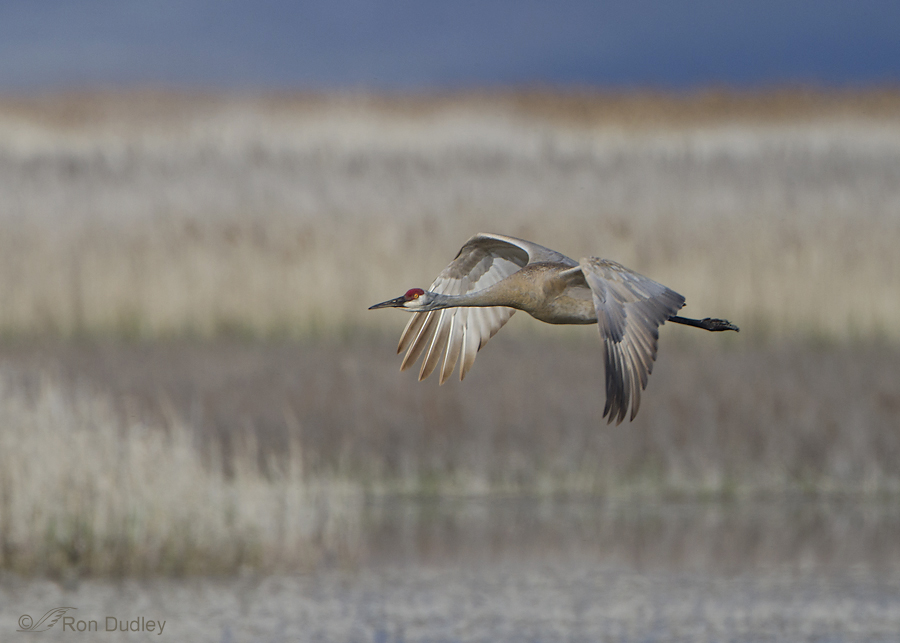
1/2000, f/6.3, ISO 500, 500 f/4, 1.4 tc
At first she was content to let the male make all the noise.
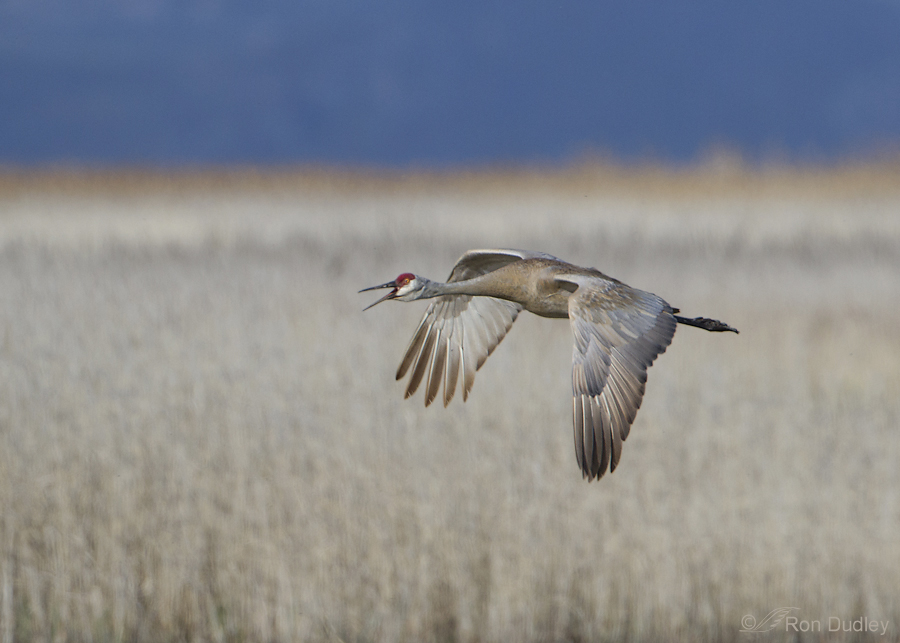
1/2500, f/6.3, ISO 500, 500 f/4, 1.4 tc
But she soon joined in the cacophony.
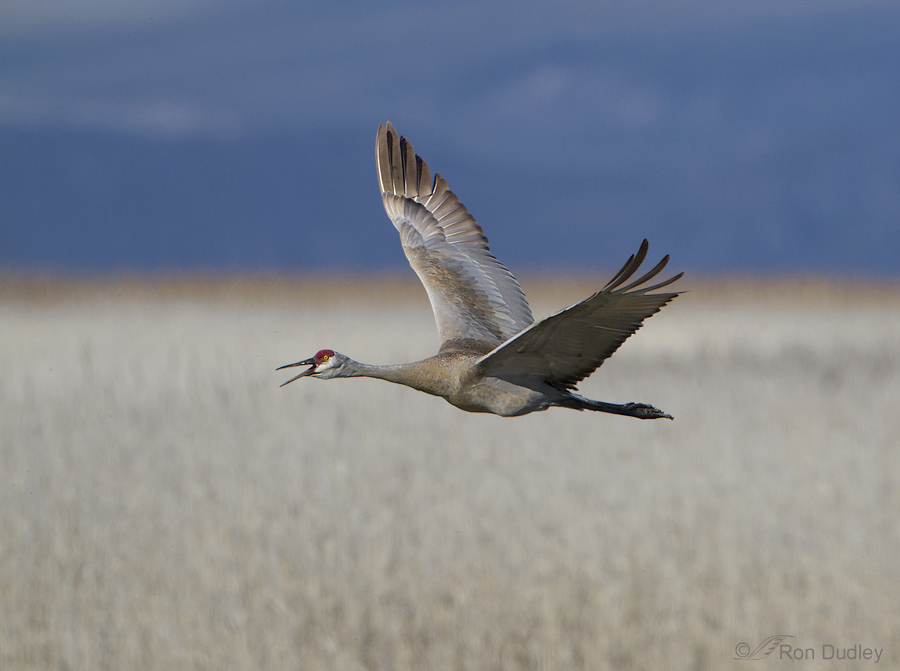
1/2500, f/6.3, ISO 500, 500 f/4, 1.4 tc
This is the last shot I got of her that I liked as she rose up into the shaded and moody Promontory Mountains in the upper background. The bird is a bit centered in the frame but I had no more room on the left.
A few days ago as Mia and I were out looking for birds to photograph (mostly unsuccessfully) the topic of conversation turned to the birds we’re most looking forward to seeing again this spring. The Sandhill Crane was at the top of our list.
Ron


Thanks for the link to their vocalizations. It was great to see your images, while hearing and reading about their differences. Full Sandhill Crane immersion!
I’m glad you enjoyed the vocalization link, Mike. I think it’s fun to listen to while looking at the photos.
The Sandhill Cranes are at the top of my list as well Ron. I’ve spent some time studying sound production in birds. I remember when I learned about the elongated trachea in the Sandhill Cranes, and the various other birds that are, to my surprise, quite unrelated. You can definitely hear what it does for the Sandhill Cranes. Their loud rattling calls definitely benefit from the extra resonance of an elongated trachea. I read a great article by a man fascinated with the subject, William Tecumseh Fitch. His idea is that it serves as size exaggeration. I suggest reading this as you are a biologist and like cool stuff, like me. Haha. Read it here:
http://www.st-andrews.ac.uk/~wtsf/downloads/Fitch1999Trachea.pdf
I just love the internet, don’t you?!
Thanks again for the wonderful post Ron.
Wow, that’s an incredibly interesting hypothesis, Bryce. And I had no idea that coiling could be so dramatic and was found in so many species. It’s a long article to read but I would encourage anyone interested in birds to at least open the link and look at fig.1. It’s a jaw-dropper.
You’re so right, Ron, about the call … magical, haunting, primordial. I love looking at the anatomy as they launch across the water. Oh, and, I’m really into that unconventional composition, especially when it comes to showing evidence of the trail behind.
Thanks, Ingrid. I like the water splashes too.
Wonderful sequence shots of the take-off process! Good news – the migratory Sandhill Cranes here are grouping up and feeding heavily so should be headed to you soon. Florida has a healthy native population which remains year around and some have already produced chicks. Our warm winter seems to have spurred an “early spring”. We have a pair which fly over the house each morning as they leave the roost so we get to use that wonderful call as an alarm clock.
That IS good news, Wally – thanks for the heads up. I’m jealous of your alarm clock.
Love this sequence! Do they do a “running take-off”? That’s what the first few shots look like to me? As for the vocalizations, I looked them up on allaboutbirds before I got to your link– there is not a whole lot of surface similarity to the two sites’ recordings! I’ll go with yours. The explanation of the anatomy allowing the call is fascinating.
Chris, Yes, they very often do a running take-off. Thanks for appreciating the anatomy info.
Beautiful, striking shots. I remember hearing these birds through the mist at Mac’s Inn while fishing many years ago and, yes, it can be eerie!
It’s an experience most folks don’t forget, Tana.
An amazing sequence Ron. What strength it must take a “lift off ” ! Thanks for the vocalizations link as well. Very cool.
Thanks very much, John. I’m glad you enjoyed hearing the vocalizations also.